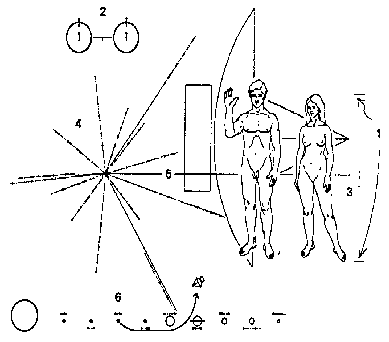The SearchForIntraTerrestrialIntelligence. Since it seems plain that civilizations on our scale that do not self-destruct will rapidly and inevitably give rise to GodGoo, searching the sky for radio signals from the likes of us is preposterous. The FermiParadox is no paradox, and we should instead array the world's electron microscopes in tandem and start a systematic search for intelligent nano-artifacts in any drop of seawater.
Or maybe there's an even cheaper way to do it:
- Take the Pioneer plaque:

- Use a NanoManipulator to knit a 1:1000000000 copy of this out of BuckyTubes.
- Make several billion copies and sprinkle them in places that nanites are likely to visit. Where? Probably any strong source of enthalpy any place. Stir them into a nice hot cup of tea, for example. Drop 'em in a volcano caldera. Fire 'em at the sun. Swallow 'em.
- Wait a few moments for the nanites to figure the message out, scan your structure, and engineer a copy of themselves slow enough to communicate with you.
- Hope they don't interpret the lack of genitalia on the diagram of the human female as a request.
~~
PeterMerel
I have a few practical objections to this - sorry to be a spoil-sport.
- If GodGoo is everywhere including here, why haven't we found it yet? We've certainly dredged enough things out of the soil, ocean, rock, etc and shoved 'em under electron microscopes by now; wouldn't a nice big nanomachine invite a bit of curiosity? Sure, we're discovering new species of bacteria every day, but it's not that common we discover entire new classes of bacteria-sized organisms. It happens, but they tend to get overlooked 'cause they look like bacteria anyway.
- Simplest explanation: there are more nano-motes to look at in a drop of water, at electron microscopic scale, than there are stars in the sky. The chances of any researcher catching one are vanishingly small without a systematic sieve. And the chances of such a lucky researcher mis-identifying a "Wow!" nanograph as just another crystal approach unity.
- Second simplest explanation: They're not interested in being found. They know they're under the scope so camouflage themselves as just another bit of floating fnafna.
- Energy. Any advanced species would want as reliable a source of energy as they could get; if I were them, I certainly wouldn't my energy source constrained by anything as short-term as a living being or geological feature. They'd probably require at least a few macro-scale structures for this.
- Sure. Look up at the night sky. See all their generators? Oh, we call them stars ...
- Communication. You're an uber-intelligence in a little nanoscale bottle; of course you want to talk to other people. How do you do it? Well, radio is the traditional way. Might be difficult, 'cause wavelengths short enough to receive tend to be high-energy enough to be dangerous. Unless you want to build millimeter+ antennae, that basically leaves direct contact of one way or another. Not exactly ideal, unless you want to build large (again, probably macro-scale) colonies of nanites. Well, or you might be able to put together a complex chemical message-in-a-bottle and stick it to a passing bacterium in the hopes it'll reach someone interesting. Hmm... I may have out-smarted myself, this time. Are viruses the messenger-pigeons of a nanoscale civilization?
- Could be. Or maybe they just orient themselves through some quantum mechanism and lase with minimal energy loss. Just because we're too dumb to engineer with real physics doesn't mean they are.
- Scale. An atom is about 10E-11 meters across. Our best current fab tech (March 06) is just getting the hang of chips with features 6.5E-8 meters across. If we manage to push that down a few orders of magnitude, ignoring all the other architectural problems, a computer chip the size of one's thumbnail should be about a thousand times more powerful, yes? Well, maybe a million, but I'm going to say a thousand. Is that powerful enough to simulate a human intelligence? I don't know. It sounds like it could be. But then, computer power has already increased a thousand times in the last twenty years. In fact, we already have supercomputers that powerful, and I don't see HAL around. However, I'm just trying to make a general point: even if you figure out how the human brain works, duplicating it in something with less volume than a human brain is going to be, if not impossible, then very hard.
- You don't know that. All our computability and complexity results are relevant only for the VonNeumannArchitecture. Even we know a lot of other ways to hook up transistors. And we don't know that transistors are the only game in town, neither. What passes for ComputerScience among humans probably seems similar to CleverHans to a GodGoo.
...anyway. That was fun.
--
Then there's STI, the Search for Terrestrial Intelligence. Like SETI, they haven't found anything yet.
See also: EarlyUniverseIntelligence
 Search For Intra Terrestrial Intelligence
Search For Intra Terrestrial Intelligence Search For Intra Terrestrial Intelligence
Search For Intra Terrestrial Intelligence
 EditText of this page
(last edited February 23, 2009)
or FindPage with title or text search
EditText of this page
(last edited February 23, 2009)
or FindPage with title or text search